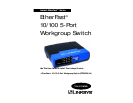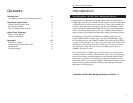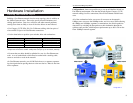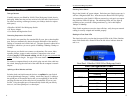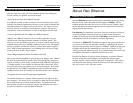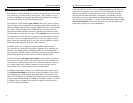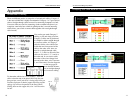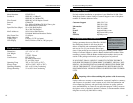
About Fast Ethernet
History of Fast Ethernet
Standard Ethernet has been the most popular networking technology during
this past decade, with a maximum data throughput of 10Mbps. But the
Ethernet standard has fallen out of favor as today’s massive graphics, multi-
media, and other data-intensive applications have magnified the problem of
lagging network performance.
Fast Ethernet now dominates as the most viable and economical solution to
resolve the problem of network speed over all other market alternatives.
Capable of sending and receiving data at 100 Mbps, its bandwidth more than
accommodates even the most intensive real-time applications.
Also known as 100BaseTX, Fast Ethernet supports high speed signaling and
gives users an efficient and affordable solution for upgrading their present
network to the upcoming standard speed of 100Mbps. 100BaseTX data pack-
et lengths and formats are transmitted over two pairs of Category 5 UTP
cabling, just like the 10BaseT system. It uses identical data error control and
management information as 10BaseT transmissions as well.
Because Fast Ethernet is based on similar technology to standard Ethernet,
the issue of migrating from 10Mbps to the higher Fast Ethernet speed
requires virtually no effort with the right piece of equipment. All it takes is
your EtherFast Auto-Sensing Switch to coordinate your network hardware,
and you’re ready to run a top-notch system.
7
10/100 5-Port Workgroup Switch
6
Instant EtherFast
®
Series
Tips on Switching Your Network
Here are some of the ways your new EtherFast 10/100 5-Port Workgroup
Switch can help you optimize your network speed.
• Speed up Nodes From Your 10BaseT Network
In a 10BaseT network, connect your hubs, file servers and key users such as
managers and network administrators directly to your Switch to channel dedi-
cated bandwidth in full duplex mode to each station. The Switch can com-
municate with all its connections simultaneously, whereas a hub can only
communicate with one workstation at a time, in half duplex transfer mode.
• Conserving Bandwidth with 10Mbps & 100Mbps Segments
10BaseT and 100BaseTX hardware are not readily compatible, but your
10/100 Switch can designate network segments of different speeds. This
allows you to run one 10mbps segment to serve users without a need for con-
siderable speed, and a faster 100mbps segment devoted to users who depend
heavily on graphics, multimedia, database, or other speed-intensive applica-
tions. With switched segmentation, your 100mbps users will not be slowed
down by the users on the 10mbps segment.
• Run 10Mbps Peripherals in Your Fast Ethernet Network
Most of the network peripherals in place today run at 10mbps, since 10BaseT
has been the standard network speed to date. These peripherals, designed to
operate at 10mbps, cannot readily communicate with 100BaseTX equipment.
A 10mbps interface is also required for cable and DSL connections, which
are quickly becoming very popular ways to access the Internet. Your 10/100
Switch provides your 10BaseT equipment and cable and DSL lines with a
10Mbps interface while still running your Fast Ethernet devices at 100mbps.
• Strengthen Data Transfers Through Signal Regeneration
Your Switch functions as a repeater, which regenerates data signals as they
pass through it. This feature acts as a safeguard to deter data loss and ensure
that transmissions arrive at their destination intact. Switches positioned
between hubs can preserve your data’s integrity and eliminate your need to
buy and use repeaters in your Fast Ethernet network.



